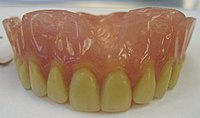
Photo from wikipedia
Candida albicans is a common overgrowth in people wearing dentures. Long-term use of antifungal chemicals carries a risk of toxic side effects. This study focused on the edible Piper betle… Click to show full abstract
Candida albicans is a common overgrowth in people wearing dentures. Long-term use of antifungal chemicals carries a risk of toxic side effects. This study focused on the edible Piper betle extract because of its safety. The broth dilution method was applied for antifungal determination of the ethyl acetate fractionated extract (fEA) and fEA-loaded polymeric micelles (PMF). The PMF was prepared by thin-film hydration using poloxamer 407 as a polymer base. The results found that the weight ratio of fEA to polymer is the main factor to obtain PMF system as a clear solution, nanoparticle sizes, narrow size distribution, negative zeta potential, and high entrapment efficiency. The activity of PMF against C. albicans is significantly higher than fEA alone, with a minimum fungicidal concentration of 1.5 mg/mL. PMF from 1:3 ratio of fEA to polymer is used to develop a denture-soaking solution contained 1.5 mg fEA/mL (PMFS). A clinical study on dentures of 15 volunteers demonstrated an 86.1 ± 9.2% reduction of C. albicans after soaking the dentures in PMFS daily for 14 days. Interestingly, PMFS did not change the hardness and roughness of the denture base resins. The developed PMFS may serve as a potential natural denture-soaking solution against candidiasis in denture wearers.
Journal Title: Antibiotics
Year Published: 2021
Link to full text (if available)
Share on Social Media: Sign Up to like & get
recommendations!